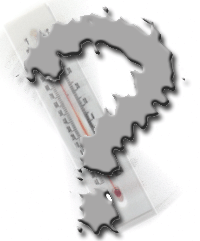The Australian Bureau of Meteorology collects one-second records and can turn them into newspaper headlines. In contrast, the UK averages its readings over one minute, and the US over five. Obviously longer averaging could slow the latter down in the PR stakes (if that was their aim).
Hypothetically old glass thermometers just wouldn’t be as good at generating headlines. They take a lot longer to respond to bursts of hot air, sometimes missing short heatwaves completely (the kind that last less than a minute). It’s potentially quite an unfair race to run the two different thermometers in the same competition. It all depends on the handicap applied to the faster electronic ones.
In 2015 Bill Johnston warned that the introduction of electronic sensors in the late 1990s was artificially warming the records and asked the Bureau for data from the two different kinds of instruments side by side. The Bureau said they throw that data away (as you would). Lately, Jen Marohasy asked the Bureau for the manufacturing specifications and the Bureau said it’s all fine, the electronic thermometers were ‘purpose-designed’ to the Bureau’s specifications. We just don’t know what those specifications are exactly. No documentation. No data. (Send in your best guess.)
When it comes to publishing handicapping procedures, horse Racing Victoria lays it out:
“All racing participants, as well as the general public, have every right to gain an understanding into the way in which their horse is handicapped. … In all instances, Handicappers must be able to provide logical and reasoned explanation for their decisions made. “
We can only hope our BoM should aim that high.
Don’t miss a great Spectator piece this week from Jennifer Marohasy on her quest to find out whether our BoM meets international standards, and whether our new thermometers are fit for purpose (and comparable to our old thermometers):
More hot days — or “purpose-designed” temperature sensors at play?
For about five weeks now the Bureau have been obfuscating on this point. There is ‘more than one way’ of achieving compliance with WMO guidelines they write in a ‘Fast Facts’ published online on September 11 – after I wrote a blog post detailing how their latest ‘internal review’ confirmed they were in contravention of international standards.
The Bureau has been insisting for some time that they don’t need to average because they have sensors with a long response time, which actually represent an average value, that is the same as the time constant for a mercury thermometer.
How this is achieved in practice was detailed for the first time in a letter from the new head of the Bureau Andrew Johnson, last Friday.
The letter explains that all the sensors the Bureau uses have been ‘purpose-designed’. I had been requesting manufacture’s specifications, but instead, I received this advice that it’s to Bureau specifications and, by inference, there is no documentation. To be clear, there are also no reports detailing the laboratory and field tests that explain how the custom-built devices have been designed to ‘closely mirrors’ the behaviour of mercury thermometers including the time constants – to quote from Dr Johnson’s letter of last Friday.
I am not blaming the sensors for being so responsive, just the Bureau for pretending one-second spot-readings from their purpose-designed sensor are comparable with instantaneous readings from mercury thermometers – while providing no proper documentation.
Read it all at The Spectator.
